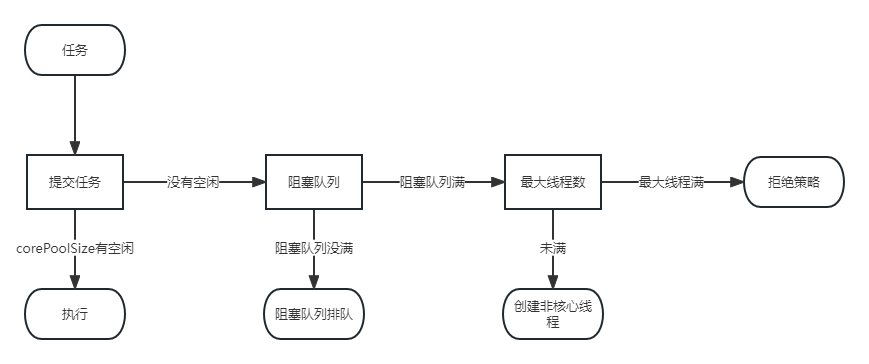- 创建线程的几种方式
- Thread
- Runnable
- Callable(配合Future获取返回值)
- 线程池
- Executors
- ThreadPoolExecutor
- 线程池ThreadPoolExcecutor的7个参数
1
2
3
4
5
6
7
8
9
10
11
12
13
14
15
16
17
18
19
20
21
22
23
24
25
26
27
28
29
30
31
32
33
34/**
* Creates a new {@code ThreadPoolExecutor} with the given initial
* parameters.
*
* @param corePoolSize the number of threads to keep in the pool, even
* if they are idle, unless {@code allowCoreThreadTimeOut} is set
* @param maximumPoolSize the maximum number of threads to allow in the
* pool
* @param keepAliveTime when the number of threads is greater than
* the core, this is the maximum time that excess idle threads
* will wait for new tasks before terminating.
* @param unit the time unit for the {@code keepAliveTime} argument
* @param workQueue the queue to use for holding tasks before they are
* executed. This queue will hold only the {@code Runnable}
* tasks submitted by the {@code execute} method.
* @param threadFactory the factory to use when the executor
* creates a new thread
* @param handler the handler to use when execution is blocked
* because the thread bounds and queue capacities are reached
* @throws IllegalArgumentException if one of the following holds:<br>
* {@code corePoolSize < 0}<br>
* {@code keepAliveTime < 0}<br>
* {@code maximumPoolSize <= 0}<br>
* {@code maximumPoolSize < corePoolSize}
* @throws NullPointerException if {@code workQueue}
* or {@code threadFactory} or {@code handler} is null
*/
public ThreadPoolExecutor(int corePoolSize,
int maximumPoolSize,
long keepAliveTime,
TimeUnit unit,
BlockingQueue<Runnable> workQueue,
ThreadFactory threadFactory,
RejectedExecutionHandler handler)- corePoolSize(核心线程数)
- maximumPoolSize(最大线程数)
- keepAliveTime、unit(最大空闲时间)
- workQueue(阻塞队列)
- threadFactory(线程工厂,为线程自定义名称)
- handler(拒绝策略)
- 线程池执行流程

- 线程池属性标识
1
2
3
4
5
6
7
8
9
10
11
12
13
14
15
16
17
18
19
20
21
22
23
24
25
26
27
28
29
30
31
32
33
34
35
36
37
38
39
40
41
42
43
44
45
46
47
48
49
50
51
52
53
54
55
56
57
58
59
60
61
62
63
64
65
66
67
68
69
70
71
72
73
74
75
76
77
78
79
80
81
82
83/**
* The main pool control state, ctl, is an atomic integer packing
* two conceptual fields
* workerCount, indicating the effective number of threads
* runState, indicating whether running, shutting down etc
*
* In order to pack them into one int, we limit workerCount to
* (2^29)-1 (about 500 million) threads rather than (2^31)-1 (2
* billion) otherwise representable. If this is ever an issue in
* the future, the variable can be changed to be an AtomicLong,
* and the shift/mask constants below adjusted. But until the need
* arises, this code is a bit faster and simpler using an int.
*
* The workerCount is the number of workers that have been
* permitted to start and not permitted to stop. The value may be
* transiently different from the actual number of live threads,
* for example when a ThreadFactory fails to create a thread when
* asked, and when exiting threads are still performing
* bookkeeping before terminating. The user-visible pool size is
* reported as the current size of the workers set.
*
* The runState provides the main lifecycle control, taking on values:
*
* RUNNING: Accept new tasks and process queued tasks
* SHUTDOWN: Don't accept new tasks, but process queued tasks
* STOP: Don't accept new tasks, don't process queued tasks,
* and interrupt in-progress tasks
* TIDYING: All tasks have terminated, workerCount is zero,
* the thread transitioning to state TIDYING
* will run the terminated() hook method
* TERMINATED: terminated() has completed
*
* The numerical order among these values matters, to allow
* ordered comparisons. The runState monotonically increases over
* time, but need not hit each state. The transitions are:
*
* RUNNING -> SHUTDOWN
* On invocation of shutdown(), perhaps implicitly in finalize()
* (RUNNING or SHUTDOWN) -> STOP
* On invocation of shutdownNow()
* SHUTDOWN -> TIDYING
* When both queue and pool are empty
* STOP -> TIDYING
* When pool is empty
* TIDYING -> TERMINATED
* When the terminated() hook method has completed
*
* Threads waiting in awaitTermination() will return when the
* state reaches TERMINATED.
*
* Detecting the transition from SHUTDOWN to TIDYING is less
* straightforward than you'd like because the queue may become
* empty after non-empty and vice versa during SHUTDOWN state, but
* we can only terminate if, after seeing that it is empty, we see
* that workerCount is 0 (which sometimes entails a recheck -- see
* below).
*/
// 1.高3位:声明当前线程池状态 2.低29位:声明线程池中的线程个数
private final AtomicInteger ctl = new AtomicInteger(ctlOf(RUNNING, 0));
// 29,方便后面做位运算
private static final int COUNT_BITS = Integer.SIZE - 3;
// 通过位运算得出最大容量
private static final int CAPACITY = (1 << COUNT_BITS) - 1;
// 线程池状态
// runState is stored in the high-order bits
// 111 正常接收任务
private static final int RUNNING = -1 << COUNT_BITS;
// 000 不接收新任务,仍会处理阻塞队列中的任务,正在进行中的任务也正常进行
private static final int SHUTDOWN = 0 << COUNT_BITS;
// 001 不接收新任务,不处理阻塞队列中的任务,中断正在进行中的任务
private static final int STOP = 1 << COUNT_BITS;
// 010 过渡状态,当前线程池即将结束
private static final int TIDYING = 2 << COUNT_BITS;
// 011 结束
private static final int TERMINATED = 3 << COUNT_BITS;
// Packing and unpacking ctl
// 获取线程池状态
private static int runStateOf(int c) { return c & ~CAPACITY; }
// 获取线程池的线程数量
private static int workerCountOf(int c) { return c & CAPACITY; }
private static int ctlOf(int rs, int wc) { return rs | wc; }
线程池数量选择
- IO密集型(I/O bound)
程序处理时,CPU需要等待时间比CPU运算时间更多。
线程数量:(线程等待时间+CPU运算时间)* CPU核数 / CPU处理时间 - CPU密集型(CPU-bound)
也叫计算密集型,大部分时间用来计算、逻辑判断等CPU动作的程序。任务不太需要访问I/O,或使用线程等方式减少了IO等待时间。
线程数量:CPU个数或+1 +2
nginx IO密集型
nginx处理文件缓冲时有几种方式
- sendfile
处理小文件时使用- 减少数据拷贝,提高发送效率
- socket通过dma直接访问文件数据
- directio
处理大文件时使用- directio以512字节为边界对齐block进行发送
- 未对齐的block以阻塞方式读取发送
- aio
- airead
- 线程池异步读取较大文件,以提高io效率
redis CPU密集型
io-threads = 4
非阻塞IO
多路复用
IO线程作用于
这就要看其中read、send中的线程等待时间多,还是decode、encode使用CPU运算时间多。由于我们使用非阻塞IO,无需等待,所以decode、encode时CPU运算时间多,最后得出结论Redis是 CPU密集型